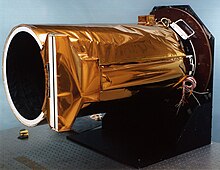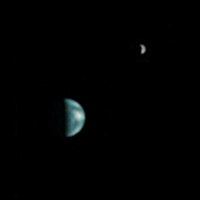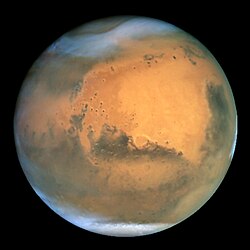Mars Orbiter Camera

Mars Observer Camera a Mars Orbiter Camera (MOC) byly vědecké přístroje na palubě umístěné na planetárních sondách americké NASA Mars Global Surveyor (MGS) a Mars Observer. Pracovaly jako fotografické kamery pro širokoúhlé i detailní snímky, které pro společnost NASA postavila firma Malin Space Science Systems (MSSS). Náklady na celý vědecký výzkumný projekt MOC byly asi o 44 milionů USD vyšší, než se předpokládalo v rozpočtu.[1] Sonda Mars Global Surveyor byla vytvořena ve spolupráci s Jet Propulsion Laboratory (JPL), vypuštěna v listopadu 1996 a oběžné dráhy Marsu dosáhla v září 1997. Svou primární misi dokončila v lednu 2001.
Historie
Zařízení se původně jmenovalo Mars Observer Camera a bylo v roce 1986 vybráno společností NASA pro misi Mars Observer, ale na Zem se před ztrátou kosmické sondy v roce 1993 vrátily pouze tři snímky planety Mars. Druhá kamera ze stejnou specifikací bylo přejmenována na Mars Orbiter Camera (MOC) a byla postavena (s pomocí California Institute of Technology) a zprovozněna na palubě sondy Mars Global Surveyor (MGS) v roce 1996. Fotografická kamera na Zem poslala 243 668 snímků pořízených z oběžné dráhy Marsu; v roce 2006 bylo se sondou ztraceno spojení.[1] Kamera Mars Orbiter Camera byla obsluhována jejím výrobcem Malin Space Science Systems, z jejich základny v kalifornském San Diegu.[2] Od roku 1998 kamera pořizovala také detailní obrázky povrchu obou měsíců Marsu.
Fotografická kamera disponuje rozlišením až 0,5 metru na pixel. Takového rozlišení je dosahováno speciální technikou s pomocí rotace sondy, běžné rozlišení je 1,5 m/pixel.
Galerie
Mars Observer Camera: Pohled na Mars před ztrátou kontaktu
Mars Orbiter Camera: Pohled na Mars v rozšířených barvách, uprostřed Arabia Terra (světlá oblast)[3]
Mars Orbiter Camera: Marsické polární duny, 21. července 1999[2]
Země a Měsíc z Marsu
Marsická tvář
Odkazy
Reference
- ↑ a b Archivovaná kopie. www.marsjournal.org [online]. [cit. 2012-08-29]. Dostupné v archivu pořízeném dne 2013-10-06.
- ↑ a b Archivovaná kopie. www.msss.com [online]. [cit. 2012-08-29]. Dostupné v archivu pořízeném dne 2013-12-14.
- ↑ NASA PIA02004
Související články
Společnost Malin dodala další kamery pro společnost NASA, například:
- Mars Color Imager
- Context (CTX) Camera
- JunoCam na palubě sondy Juno, která bude na orbitu Jupitera v roce 2016
Externí odkazy
Média použitá na této stránce
Courtesy NASA/JPL/Malin Space Science Systems [1] [2]
Image of Earth and Moon, taken by the Mars Orbiter Camera of Mars Global Surveyor on May 8 2003 at 12:59:58 UTC. South America is visible.
The magnitudes of the Earth and Moon are given as about −2.5 and +0.9, respectively.
On that date, Earth and Jupiter were in conjunction as seen from Mars. Jupiter was also imaged (not shown here). At that time, Earth was at elongation 43.1428° from the Sun, extremely close to its greatest eastern elongation of 43.1504° which occurred two days later.
The distance from Mars to Earth was 139.19 million km or 0.9304 AU. The illuminated fraction of Earth's disk was 43.2% and its angular diameter was 18.903".
The distance from Mars to the Moon was 139.58 million km or 0.9330 AU. The illuminated fraction of the Moon's disk was 43.3% and its angular diameter was 5.135".
The angular separation between the center of the Earth's disk and the center of the Moon's disk was 49.16", close to the minimum angular separation of 32.154" which occurred at 20:15 UTC. The moon is moving towards the left.
This corresponds to what an observer with a telescope would see from Mars; a naked-eye observer would simply see a single point of light. Usually, the Earth and Moon are visible as two separate points of light, but at this point in the Moon's orbit they are too close to resolve with the naked eye as seen from Mars.
Note that because the Moon is almost directly behind the Earth, a telescopic observer on Mars would see almost exactly the same lunar features that an observer on Earth would see at this point in time, namely the first quarter (half moon) of the near side of the Moon. In the following days after this image was taken, the views of the Moon as seen from Earth and Mars would diverge sharply. An observer on Earth would continue to see the same side (near side) of the Moon, while the Moon's phase would continue to grow ("wax") as it approached full moon about one week later; by contrast, an observer on Mars would continue to see the Moon maintain very nearly the same phase, but would see it rotate (from left to right). About two weeks later (halfway around in its orbit), the Moon would once appear to be very close to the Earth, but in front of it rather than behind, and the far side rather than the near side would be visible; the far side can never be seen from Earth.
We can get the exact time from the data file associated with the original image [3]. The Earth is centered at 935 pixels from the bottom of the original 5760-pixel-high image; the Moon is centered at 980 pixels from the bottom. The image start time is 12:59:55.00 UTC, the line integration time is 3.5000 milliseconds and the downtrack summing factor is 1. Thus we add (935 * 0.0035 * 1) = 3.27 seconds offset from image start time for the center of the Earth's image, and (980 * 0.035 * 1) = 3.43 seconds offset for the center of the Moon's image.
This view can be reproduced with the JPL Solar System Simulator:
- closeup, showing the orientation of South America and North America
- closeup of the Moon, showing the near side at first quarter
- wider view, showing the Moon as well
- wide angle view showing the size of the Moon's orbit
- wider angle view showing Jupiter as well
NASA's Hubble Space Telescope took the picture of Mars on June 26, 2001, when Mars was approximately 68 million kilometers (43 million miles) from Earth — the closest Mars has ever been to Earth since 1988. Hubble can see details as small as 16 kilometers (10 miles) across. The colors have been carefully balanced to give a realistic view of Mars' hues as they might appear through a telescope. Especially striking is the large amount of seasonal dust storm activity seen in this image. One large storm system is churning high above the northern polar cap (top of image), and a smaller dust storm cloud can be seen nearby. Another large dust storm is spilling out of the giant Hellas impact basin in the Southern Hemisphere (lower right).
Photograph of the planet Mars taken at 8:52 p.m. Pacific Daylight Time on July 26 by the high resolution, narrow-angle telescope of the Mars Observer Camera. At that time, the Mars Observer spacecraft was 5.8 million kilometers (3.6 million miles) and 28 days from its encounter with Mars. The resolution in this image is approximately 21.5 km (13.4 mi) per picture element and Mars, roughly 6,800 km (4,200 miles) in diameter, is about 315 picture elements across. North is to the top of the image; the south pole is near the bottom but in shadow. The sunrise line (terminator) stretches across the morning hemisphere from lower right to upper left. At this distance from Mars, only bright and dark markings resulting from variations in the amount and thickness of dust and sand are visible. Toward the bottom of the picture is a bright, roughly circular area called Hellas, an impact basin 2,000 km (1,250 mi) across. The dark area in the center of the frame is Syrtis Major, a region of volcanic plains and dark sand dunes. At the top of the photograph is Nilosyrtis, an area of buttes, mesas and box canyons reminiscent of the deserts of the southwest United States. Launched on Sept. 25, 1992, Mars Observer will enter Mars orbit on Tuesday, Aug. 24, at about 1:30 p.m. PDT. In-orbit engineering checkout of the camera is scheduled to begin Sept. 16. The camera and six other investigations begin mapping operations from a circular orbit just 400 km (248 mi) above the surface on Nov. 22. The Mars Observer Camera was developed by and is operated under contract to Jet Propulsion Laboratory by an industry/university team led by Malin Space Science Systems, San Diego, Calif.
Mars Observer Camera (MOC) (renamed Mars Orbiter Camera on Mars Global Surveyor) science investigation used 3 instruments: a narrow angle camera that obtained grayscale (black-and-white) high resolution images (typically 1.5 to 12 m per pixel) and red and blue wide angle cameras for context (240 m per pixel) and daily global imaging (7.5 km per pixel). MOC operated in Mars orbit between September 1997 and November 2006. It returned more than 240,000 images spanning portions of 4.8 Martian years.
Der Planet Mars.

![Mars Orbiter Camera: Pohled na Mars v rozšířených barvách, uprostřed Arabia Terra (světlá oblast)[3]](http://upload.wikimedia.org/wikipedia/commons/thumb/0/06/Mars_2.jpg/200px-Mars_2.jpg)
![Mars Orbiter Camera: Marsické polární duny, 21. července 1999[2]](http://upload.wikimedia.org/wikipedia/commons/thumb/d/d2/Moc2_166b_msss.gif/200px-Moc2_166b_msss.gif)








